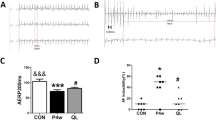Abstract
Epigallocatechin-3 gallate (EGCG) is the major catechin in green tea. The aim of this study is to investigate the effects of EGCG on atrial electrical and structural remodeling in a rabbit rapid atrial pacing (RAP) model. New Zealand white rabbits were subjected to RAP with or without EGCG treatment. The atrial electrophysiology was studied. ELISA, Western blots, and RT-PCR were performed to determine the level of the inflammation markers, oxidative stress, and fibrogenic agents. Atrial tissue was stained with Masson’s trichrome stain for fibrosis detection. RAP rabbits showed a significantly shorter atrial effective refractory period than control rabbits. Higher AF inducibility and longer AF duration were seen in the RAP group. AERP of rabbits received high dose EGCG were prolonged compared to RAP rabbits, and AF inducibility and duration of rabbits received high dose EGCG were lower. RAP rabbits have higher inflammation markers, higher oxidative stress, and more significant fibrosis within atrium, while high dose intervention of EGCG can lower the inflammation, oxidative stress, and fibrosis induced by RAP. Results showed that EGCG have protective effects on atrial electrical and structural remodeling in a rabbit RAP model in terms of attenuating of inflammation and oxidative stress.





Similar content being viewed by others
References
Page, R. L. (2004). Clinical practice. Newly diagnosed atrial fibrillation. New England Journal of Medicine, 351, 2408–2416.
Beyerbach, D. M., & Zipes, D. P. (2004). Mortality as an endpoint in atrial fibrillation. Heart Rhythm, 1, B8–B18. discussion B18-9.
Burstein, B., & Nattel, S. (2008). Atrial fibrosis: Mechanisms and clinical relevance in atrial fibrillation. Journal of the American College of Cardiology, 51, 802–809.
Goudis, C. A., Kallergis, E. M., & Vardas, P. E. (2012). Extracellular matrix alterations in the atria: Insights into the mechanisms and perpetuation of atrial fibrillation. Europace, 14, 623–630.
Guo, Y., Lip, G. Y., & Apostolakis, S. (2012). Inflammation in atrial fibrillation. Journal of the American College of Cardiology, 60, 2263–2270.
Issac, T. T., Dokainish, H., & Lakkis, N. M. (2007). Role of inflammation in initiation and perpetuation of atrial fibrillation: A systematic review of the published data. Journal of the American College of Cardiology, 50, 2021–2028.
Korantzopoulos, P., Kolettis, T. M., Galaris, D., & Goudevenos, J. A. (2007). The role of oxidative stress in the pathogenesis and perpetuation of atrial fibrillation. International Journal of Cardiology, 115, 135–143.
Liu, T., Korantzopoulos, P., & Li, G. (2012). Antioxidant therapies for the management of atrial fibrillation. Cardiovascular Diagnosis and Therapy, 2, 298–307.
Islam, M. A. (2012). Cardiovascular effects of green tea catechins: Progress and promise. Recent Patents on Cardiovascular Drug Discovery, 7, 88–99.
Paquay, J. B., Haenen, G. R., Stender, G., et al. (2000). Protection against nitric oxide toxicity by tea. Journal of Agriculture and Food Chemistry, 48, 5768–5772.
Ramesh, E., Geraldine, P., & Thomas, P. A. (2010). Regulatory effect of epigallocatechin gallate on the expression of C-reactive protein and other inflammatory markers in an experimental model of atherosclerosis. Chemico-Biological Interactions, 183, 125–132.
Shen, C. L., Samathanam, C., Tatum, O. L., et al. (2011). Green tea polyphenols avert chronic inflammation-induced myocardial fibrosis of female rats. Inflammation Research, 60, 665–672.
Nattel, S., Burstein, B., & Dobrev, D. (2008). Atrial remodeling and atrial fibrillation: Mechanisms and implications. Circulation: Arrhythmia and Electrophysiology, 1, 62–73.
Psychari, S. N., Apostolou, T. S., Sinos, L., et al. (2005). Relation of elevated C-reactive protein and interleukin-6 levels to left atrial size and duration of episodes in patients with atrial fibrillation. American Journal of Cardiology, 95, 764–767.
Conway, D. S., Buggins, P., Hughes, E., & Lip, G. Y. (2004). Relationship of interleukin-6 and C-reactive protein to the prothrombotic state in chronic atrial fibrillation. Journal of the American College of Cardiology, 43, 2075–2082.
Dernellis, J., & Panaretou, M. (2005). Effect of C-reactive protein reduction on paroxysmal atrial fibrillation. American Heart Journal, 150, 1064.
Lin, P. H., Lee, S. H., Su, C. P., & Wei, Y. H. (2003). Oxidative damage to mitochondrial DNA in atrial muscle of patients with atrial fibrillation. Free Radical Biology and Medicine, 35, 1310–1318.
Mihm, M. J., Yu, F., Carnes, C. A., et al. (2001). Impaired myofibrillar energetics and oxidative injury during human atrial fibrillation. Circulation, 104, 174–180.
Kostin, S., Klein, G., Szalay, Z., et al. (2002). Structural correlate of atrial fibrillation in human patients. Cardiovascular Research, 54, 361–379.
Xu, J., Cui, G., Esmailian, F., et al. (2004). Atrial extracellular matrix remodeling and the maintenance of atrial fibrillation. Circulation, 109, 363–368.
Derakhchan, K., Li, D., Courtemanche, M., et al. (2001). Method for simultaneous epicardial and endocardial mapping of in vivo canine heart: Application to atrial conduction properties and arrhythmia mechanisms. Journal of Cardiovascular Electrophysiology, 12, 548–555.
Ko, W. C., Hong, C. Y., Hou, S. M., et al. (2011). Elevated expression of connective tissue growth factor in human atrial fibrillation and angiotensin II-treated cardiomyocytes. Circulation Journal, 75, 1592–1600.
Nakajima, H., Nakajima, H. O., Salcher, O., et al. (2000). Atrial but not ventricular fibrosis in mice expressing a mutant transforming growth factor-beta(1) transgene in the heart. Circulation Research, 86, 571–579.
Acknowledgments
This project was supported by Youth Fund of the First Affiliated Hospital of Zhengzhou University.
Author information
Authors and Affiliations
Corresponding author
Rights and permissions
About this article
Cite this article
Zhu, J., Zhang, X., Li, L. et al. Protective Effects of Epigallocatechin-3 Gallate on Atrial Electrical and Structural Remodeling in a Rabbit Rapid Atrial Pacing Model. Cell Biochem Biophys 71, 897–903 (2015). https://doi.org/10.1007/s12013-014-0280-2
Published:
Issue Date:
DOI: https://doi.org/10.1007/s12013-014-0280-2




